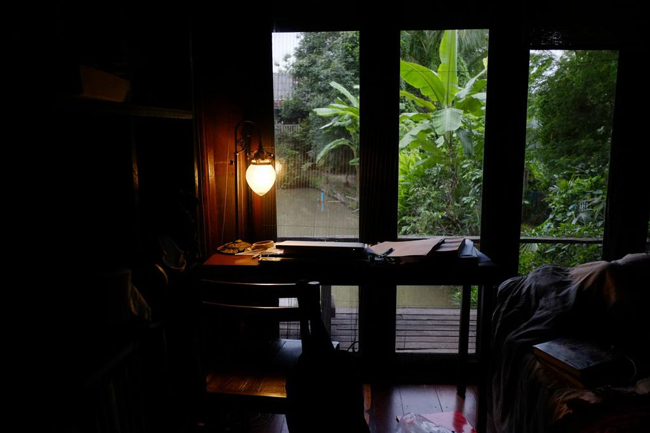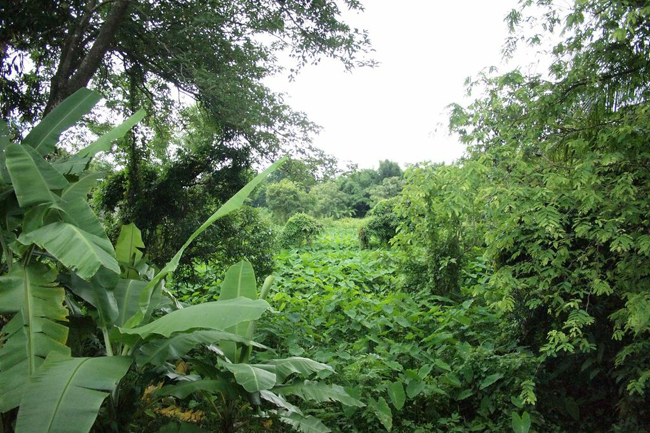APICHATPONG WEERASETHAKUL
— When I was young a close friend told me about a black man on the ceiling. The guy would cling to the upper corner above his bed like a lizard and stare down at him with luminous red eyes. For a long time this image persisted in my nightmares. I lost touch with the friend and didn’t see him again until two years ago, when I ran into him at a reunion. He had become a dentist, and I doubt he remembered that man on the ceiling. Whatever the case, the black man has somehow become a part of my bedroom, and I have seen him on the ceiling many times since.
I grew up in Khon Kaen Hospital because both of my parents were doctors there. We lived in a doctors’ residence, a two-story wooden house. In memory it seems luxurious compared to the apartment building that the hospital provides for its doctors now (actually, that hulking dorm covers the ground where our modest Thai house once stood). My friends were the children of other doctors who had finished their studies in Bangkok and were hot to start putting the knowledge to work and itching to make babies. Doctors’ kids were a part of this provincial outback, and we spent our time in uncomplicated ways. Even just walking around was fun. We rode our bikes around the grounds and flew kites on the lawn in front of the canteen. We would sit and wait for a pushcart to buy chewing gum or sail metal boats on the pond in front of the walkway. Another thing we liked to do was sit in front of the morgue to see the corpses when they were wheeled out on gurneys with their feet sticking out from under the white sheets.
The thing that wasn’t fun was walking home alone at night. As I went along the path I could hear the noise of my own footsteps on the gravel, but with every step I could also hear the sound of someone following me. The faster I ran, the faster it ran after me. I always thought that it was a ghost called a kongkoi, a type that had its feet on backwards. When it walked it looked like it was turned around and heading away from you, and it made a noise—“kok koi kok koi”. The sound of its footsteps as it ran after me seemed to get closer and closer. I didn’t realize that all I was hearing was the sound of the pebbles my own feet were kicking back.
At home at night there was usually a gecko on the outside of a window. These big lizards latch their feet onto the glass pane and bare their pale stomachs. Sometimes there were eggs dimly visible inside. (These days geckos are getting scarce because they are being caught to sell to buyers from Malaysia and Taiwan who pay hefty prices for them. They say cells from the tail can cure AIDS and cancer.) Sometimes my mother would show 8 mm movies that she had shot and edited herself. She like to film flowers and the sea. Our favourite reel was one she shot when my parents and older sister visited the USA. Sometimes she would show slides taken on our different family trips. We would sit there in the little bedroom in a hospital in the middle of nowhere looking at pictures of ourselves. It made me realize that, in addition to her work as a doctor, my mother, in collaboration with the white-bellied gecko, could conduct a mysterious ritual from her movie camera. She filled the room with images of eastern seas, the Leaning Tower of Pisa, Niagara Falls, a wax figure of Liza Minnelli, monks’ begging bowls being filled in the morning, my father playing tennis, a field of tulips.
In the darkness of my parents’ bedroom my older brother used to climb up behind the clothes cabinet and I would follow along behind him to have a look. There we found boxes of 8 mm porn movies that belonged to my father. The boxes had photos of foreigners having sex in different positions. I had never seen pictures of a penis before except the ones in my parents’ medical books, which usually showed the organ in a sorry state, dripping pus or bent and misshapen. It came as a revelation there behind the cabinet to see men’s cocks that were long and big and red and looked more than just healthy. They fixed the idea in my mind that foreigners had bigger dicks than Asians, and this was especially true of the ones on the Black men we called negroes in those days. Their cocks were long and hard like cacti.
At our house we used Darkie brand toothpaste, which had a picture of a smiling Black man on the tube. As a kid I couldn’t brush my teeth without imagining the sound of the 8 mm projector and the sight of those long Black cocks.
Secrets. Excitement. The forbidden. Keeping things hidden. Lust and death. These are the words that define cinema for me. It is like peeking at the corpses at the hospital, and my ghosts are ancient and primeval, not like the ones in Korean and Japanese movies. There is nothing majestic about them. They are bloody, full of pus and worms, and stink of decay. For me movies are a rural rebellion in shabby dress. When I make a film I can’t resist going into the forest where these rancid ghosts are because it makes me feel safe. I think of a film as a personal rite in which it is appropriate to speak in whispers to a small circle of friends, or to sit alone and dream frame by frame in a darkroom with a film printer, not at a museum.


—
Apichatpong Weerasethakul is a filmmaker, he was born in 1970, in Bangkok, Thailand and currently lives in Chiang Mai. Weerasethakul began making films and video shorts in 1994 and completed his first feature in 2000. Lyrical and mysterious, his nonlinear works deal with memory and subtly invoke social issues. In 2010, his film UNCLE BOONMEE WHO CAN RECALL HIS PAST LIVES won the Palme d’Or at the Cannes Film Festival, France. Weerasethakul has also mounted exhibitions and installations worldwide, including the multi-screen project PRIMITIVE, 2009, which was presented at Haus der Kunst, Munich, Germany; Musée d’Art Moderne de la Ville de Paris, France; and the New Museum, New York, New York, USA, among other venues. In 2012, he created the online film CACTUS RIVER for the Walker Art Center, Minneapolis, Minnesota, USA, and was featured in Documenta 13, Kassel, Germany. He received the Sharjah Biennial Prize at the 2013 Sharjah Biennial 11, UAE, and is also a recipient of the Fukuoka Prize, Japan, 2013.
www.kickthemachine.com
www.anthonyreynolds.com
www.kurimanzutto.com
